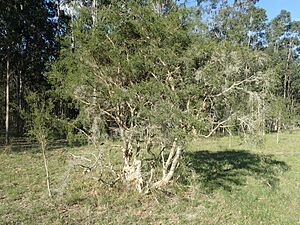Melaleuca alternifolia facts for kids
Quick facts for kids Tea tree |
|
|---|---|
 |
|
| Melaleuca alternifolia growing near Casino | |
| Scientific classification | |
| Genus: |
Melaleuca
|
| Species: |
alternifolia
|
The Tea tree, also known as Melaleuca alternifolia, is a special kind of tree or tall bush. It belongs to the myrtle family, called Myrtaceae. This plant is native to Australia, meaning it naturally grows there. You can find it in southeast Queensland and along the north coast of New South Wales. It often grows near streams and in swampy areas, sometimes being the most common plant in those spots.
Contents
What Does the Tea Tree Look Like?
The Tea tree is usually a small tree, growing up to about 7 meters (23 feet) tall. It has a bushy top and bark that looks whitish and feels like paper. Its leaves are arranged in a special way, often alternating along the stem. They are smooth, soft, and shaped like thin lines, about 10 to 35 millimeters (0.4 to 1.4 inches) long and 1 millimeter (0.04 inches) wide. These leaves are full of oil, and you can often see the tiny oil glands on them.
When the Tea tree flowers, it looks very fluffy! It produces many white or cream-colored flower spikes, each about 3 to 5 centimeters (1.2 to 2 inches) long. This usually happens in spring to early summer. After the flowers, small, woody, cup-shaped fruits appear. They are only about 2 to 3 millimeters (0.08 to 0.12 inches) wide and are scattered along the branches.
How Did the Tea Tree Get Its Name?
The scientific name for the Tea tree is Melaleuca alternifolia. It was first described in 1905 by two scientists, Joseph Maiden and Ernst Betche. They initially called it Melaleuca linariifolia var. alternifolia. Later, in 1925, another scientist named Edwin Cheel officially renamed it Melaleuca alternifolia.
The second part of its name, alternifolia, comes from Latin words. Alternus means "alternate," and folium means "leaf." This refers to how the leaves are arranged alternately on the stem.
Where Does the Tea Tree Grow?
The Tea tree is only found in Australia. It grows naturally in the Grafton area of New South Wales, extending inland towards Stroud. You can also find it in coastal areas north to Maryborough in Queensland. It loves to grow along streams and in swampy places where the ground is wet.
How Do People Use the Tea Tree?
Growing Tea Trees in Gardens
The Tea tree is quite easy to grow in many different types of soil and climates. It likes soil that drains well but stays moist. It also prefers to be grown in full sun, where it can get lots of light.
Medicinal Uses of Tea Tree Oil
Tea tree has been used as a natural medicine in Australia for a very long time. Indigenous Australians from inland areas traditionally used "tea trees" to help with coughs and colds. They would crush the leaves and breathe in the oils. They also put leaves on wounds and then covered them with a poultice, which is a soft, moist cloth. Sometimes, they would soak the leaves to make a special drink called an infusion to help with sore throats or skin problems.
Like many plants in the myrtle family, the Tea tree is used to make essential oil. It's the main plant used to produce tea tree oil, which is also called melaleuca oil. This oil is often used on the skin as an antibacterial agent. It's especially popular for treating acne because it can fight germs. It's also known to help reduce swelling and might be useful for treating fungal infections like Athlete's foot.
It's important to remember that tea tree oil should not be swallowed in large amounts because it can be harmful. If you use it on your skin, using very strong concentrations might cause irritation. While it's important to be careful, there have been no reports of deaths from tea tree oil in medical records.
Gallery
See also
 In Spanish: Árbol del té para niños
In Spanish: Árbol del té para niños







